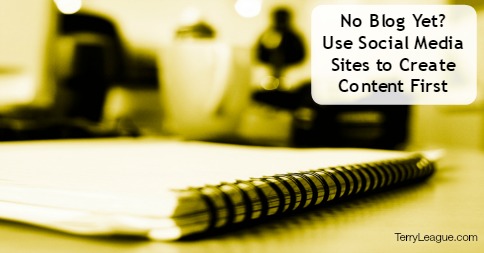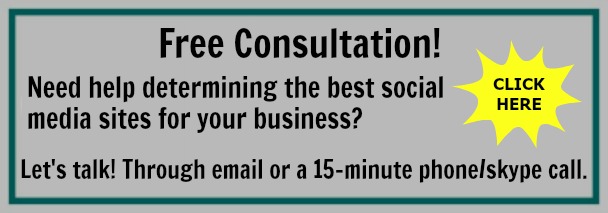
You know you need to build your personal brand, and you’ve heard that blogging is a great way to reach your target audience and share your passion / expertise on a particular topic. But how do you start blogging if you haven’t written anything before?
And what if you don’t like to write?
Luckily, there are many different ways to share great content with your audience, and if you’re active on social media, then you are probably already creating unique content that can be used to build up your blog for a later launch date.
The importance of a blog or branded website is that you designate it as the “hub” of your content. You don’t own or control the space on social media sites, and if your most-used site shut down tomorrow, where would people find your content?
If you don’t have the time or resources to start a blog or build (outsource) a website today, then use some built-in features on social sites to create original content now.
Save all of your original content (to your computer or in a tool like Evernote, Dropbox), and then use it to launch your blog or website when you can.
[last update: 7/12/16]
Social Media Sites and Their Built-In “blogging” Features
LinkedIn publishing is available for all users. You create a post right on the site, adding any photos and links. Keep in mind that this is a more professional setting, and may not be the best place to start as a beginner blogger.
(1) Facebook Notes have been around for years and although the format and visibility has changed several times, it’s a great tool for mini-blog posts. You can add an image to your Note and then share on your Profile or Page.
Make sure you turn on the visibility of Notes in your Personal Profile settings so others can quickly see what you’ve written.
(2) Facebook LIVE is growing in use as a great way to reach others through live-streaming video. If you’re more comfortable on video than writing blog posts, then use live-streaming to share your content.
You can save and embed LIVE videos, so when you start your blog, simply include the video (plus a summary in text form) in a post and then repeat consistently!
Tumblr
Tumblr is a micro-blogging platform (with a lot of emphasis on visual content), that you could start to use for blogging. Share visual content mixed in with a few mini-blogs to see how your followers engage.
Tumblr also added live video to the platform, so you have another option on this site now.
YouTube
If writing is not your thing, then the biggest video site is YouTube (although Facebook is trying to beat them with LIVE).
Start building up your YouTube channel with videos, and then when you set up your own blog site, you can always embed your videos on blog posts, and include a text summary of the video.
Twitter is not usually identified as a blogging platform because of the 140-character limitation on Tweets. But it’s a great platform to test headlines – to see what captures people’s attention.
Or maybe you’ve posted a series of Tweets on one topic and later you can put all those Tweets together for a blog post (just try not to overload your followers with 20 Tweets in 2 minutes!)
Direct messages on Twitter don’t have the same character restriction, so if you use them to have conversations with people, take note of what you’re sharing in them.
Also note that since Twitter owns the live-streaming App Periscope, and continues to build in more features that help promote your Periscope broadcasts, you can use the content from your live-streaming for later posts.
Vine
Vine has its own site to hold all of your 6-second videos if you like this shorter format. Also keep in mind that Vines show up well on Twitter and Pinterest.
SlideShare
SlideShare is a growing network and if you like putting together presentations, you can get some great visibility for your content.
(Canva has some templates available to make creating slides easy, or use PowerPoint to create slides.)
Also keep in mind that SlideShares easily upload to your LinkedIn profile, and “play” live when shared on Twitter or embedded into a blog site.
Pinterest and Instagram
When visual content is a priority to your brand/business, Pinterest and Instagram are most likely the main sites you’ll use (depending on your target audience of course).
Pins on Pinterest work best when they direct users back to a website, so you may want to get your site set up first before adding this platform.
Instagram posts also work well when you have a landing page or website to direct users to.
But you may find that your visual content reaches the right people on Pinterest and Instagram, and then when you launch your blog or website, you’ll have a targeted community eager to see more of what you share.
GOOGLE+
Google+ posts themselves are used by many for long-form updates or “mini-blog” posts. With Google+’s built-in text formatting, you can easily make your updates stand out among others’ one or two line posts.
Snapchat
I’m including Snapchat to this updated list since the platform has added the “Memories” feature.
Now you can save snaps or stories (which become Memories) that users can see and search – as opposed to the disappearing posts that made this platform unique when it launched.
If your demographic includes 18-34 year olds, and you want to have a more fun, casual connection with your target audience, you may find this site works well for you.
So what content do you create on social media sites now for your future blog?
Tips & “Snackable” Content
People like short, “snackable” bits of content, so share tips on your social media sites with the end-goal of combining those tips into a longer blog post later on.
You may get some great feedback as you share the tips individually that will help you put together a better blog post in the end.
Note: if you already have a few blog posts, turn this idea around and break up your already published post into several different tips that become numerous “snackable” posts on your social media sites.
Frequently Asked Questions
Do you answer questions from Fans on your social media sites? Start saving the questions and your answers in a document that will later become a blog post.
You may want to start holding Q & A days on your Facebook Page or in a Twitter Chat, to encourage audience engagement (giving them helpful answers while coming up with blog post ideas for you!).
Do you already have clients? What are some of the most frequently asked questions you get about your products/services?
Make a list of the top 5-10 FAQs and your answers to each can be a separate blog post. That’s 5-10 blog posts already!
So now you have some ideas for blogging: start small with “snackable” content, and take advantage of social media postings you’re already doing.
You’ll soon build up enough content to launch your blog!

